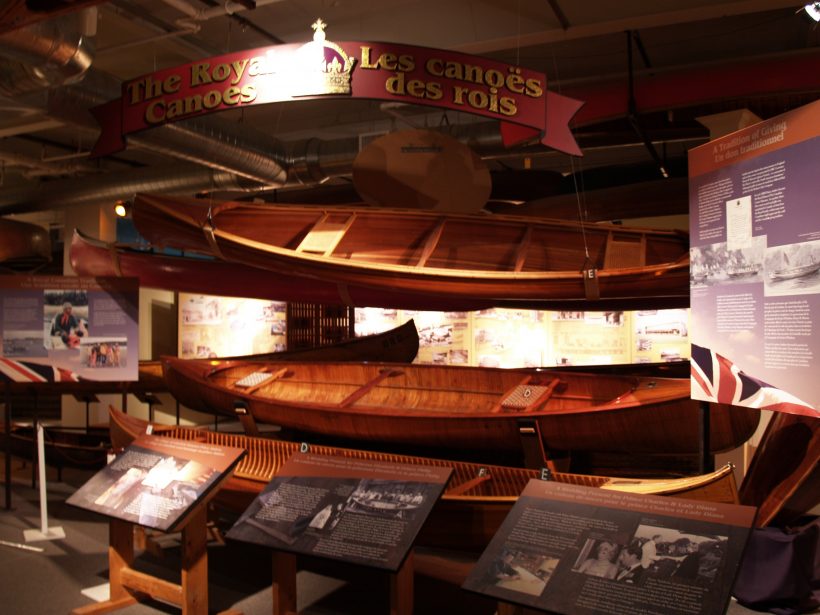THE CANADIAN CANOE MUSEUM
A LITTLE HISTORY
“Canoa, or canoe,” was adapted from the Arawak language of native Caribbean’s. Originally referring to a boat it evolved to the canoe we know to-day. Birch bark canoes were well suited to inland exploration as the material was at hand plus the craft was relatively light for portaging when compared to other materials and if properly cared for almost indestructible. One canoe maker that I knew used his birch craft to move construction materials to build himself a cabin. Of course finding trees to accommodate a birch skin to-day is challenging.
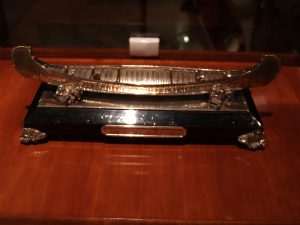
GENESIS
Word has it that in 1957 friend and mentor, University of Toronto Professor Griffiths, or “The Griff” to those who knew him, presented Kirk Wipper with a dugout circa 1890. A University of Toronto assistant professor in the School of Physical & Health Education, Wipper also owned and operated Camp Kandalore (Canada-lore) near Dorset, Ontario. That one gift resulted in the birth of the Kanawa Museum a.k.a. the Kanawa International Collection of Canoes, Kayaks and Rowing Craft, in 1975. In 1991 the name changed to The Canadian Canoe Museum (CCM), home to 600+ craft, the world’s largest collection with such a focus. In 1994 Kirk transferred control of his historic collection to the CCM.
BACKING UP
During the summer of 1970 I was a guide at Camp Kandalore and spent most of my time at the Outpost Camp on Lady Evelyn in Temagami. However, on one occasion when I was in the main camp Kirk started to build a log structure to house the craft, paddles and other unique historical aboriginal artifacts that he had collected. Oh for a camera! All of camp was pressed into action. In a scene out of a Cecil B. DeMille classic, campers and staff were employing block and tackle to raise the main centre beam around which the new building would rise. It rekindled a memory of Egyptian slaves pulling on ropes moving massive rocks into place erecting a pyramid. Except everyone was having a grand time. It was, literally, an historic moment.
As the collection grew it became apparent that a more friendly, climate controlled environment was required. In the early 90s portions of the increasingly large collection were stored in and around Peterboro, Ontario before moving into the former Outboard Marine building located at 910 Monaghan Road resurrecting a formerly vibrant location. Peterboro was a fitting site for during the years 1850-1960 it had been the centre of canoe manufacturing in Canada.
FAST FORWARD
In 1997 the museum opened to the public appropriately on Canada Day. In 2006, Prince Andrew, a member of the Canadian Royal Family, accepted the invitation to become the royal patron of the museum. He also donated, on a long-term loan, three canoes built in the Peterboro area that had been gifted to the Royal Family between 1947-1981. One was a wedding gift to Queen Elizabeth and Prince Phillip from Canada; second, a wedding gift from Pierre Trudeau to Prince Charles and Lady Dianna; and the third, a gift from the citizens of Lakefield to Prince Andrew when he attended Lakefield College School.
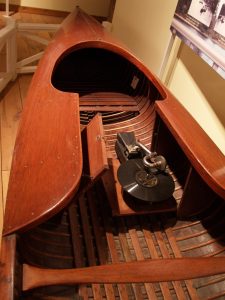
UPON REFLECTION
Founder Kirk Wipper travelled from coast to coast to coast. “He would go anywhere in Canada to collect a canoe,” said museum chair Don Curtis, a former student of Wipper’s. And so, I might add, would those working with Kirk at camp. One didn’t work for Kirk; one worked with him – an empowering difference.
During pre-camp, 1970, Dave Merrifield (aka Happypastures) and I were sent to Ottawa to find Prof. Claude Cousineau who apparently had a canoe to donate. On the way we stopped in Bancroft to drop off some washing machines for repair. We were told to leave them with Greg Langlois. No directions. Quite the contrary to to-day’s exact GPS technology. Eventually we found Langlois’ residence above his Laundromat.
I knocked on the door and immediately was invited to “Come in” by a rather unusual voice. I stepped inside. Noone was there. Then I heard “Come in” again – uttered by a caged Mynah bird. Great. There I was, a stranger in the village in a stranger’s house. Langlois said it happened, much to his amusement, “all the time.”
We had been told to look for Cousineau in Manotick, a quiet hamlet on the outskirts of Ottawa. Dave and I stopped in at the General Store run by a Mrs. Krupa. Any relation to the legendary drummer Gene Krupa? “Yes, my daughter just returned from visiting him in New York City,” she replied.
“Small world.”
While Mrs. Krupa endeavored to find the professor – she had never heard of him – she offered us a glass of milk and some apple pie. She called the postmistress, who surely would know the professor, but she didn’t answer the call. “Oh, she would be at the sulky races to-day. Care for some more pie and milk?”
Well, we never did find the professor or the canoe but we did see Fiddler on the Roof which had just opened in Ottawa. To this day I don’t know if that canoe ever arrived.
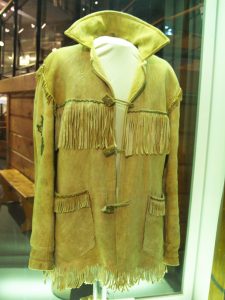
FAST FORWARD
In 2003 artisans under the direction of Jeremy Ward built a Montreal birch bark canoe measuring 11 metres (36 feet) by 2 metres (6 feet) at the widest point, in the Algonquin tradition. Eight to twelve voyageur fur traders of the 18th and 19th centuries transported as much as four tons of cargo, crew and provisions in one of these magnificent craft. Voyageurs would apparently paddle at a rate of 50 strokes a minute. On portages half the crew would carry the inverted canoe while the others would shoulder two cargo packs each weighing some 90 pounds. Following its launching at the Lang Pioneer Village the canoe went on display at the CCM.
Also on display is the “Silver Canoe”, a model valued at $84,000 according to volunteer Pat Varty. CCM Curator James Raffan had discovered the “silver canoe” in a closet in Scotland while researching his book “Emperor of the North”, a biography of Sir George Simpson, the Overseas Governor of the Hudson Bay Co., who had canoed across Canada during the years 1820-1860. Pierre Trudeau’s buckskin jacket and birch bark canoe are displayed as is the Comfort Courting Canoe built by Walter Dean of Toronto complete with a gramophone. An RCA Victor record, “A Sioux Serenade”, sits on the turntable. Also featured was a picnic basket that went the way of a “5 finger discount.” (Varty). Dean built this model at Sunnyside on the ground floor of the Palais Royale Pavilion in the late 19th and early 20th centuries. Entertainment at the Palais Royale has ranged from the big band era to the Rolling Stones. Sunnyside itself still is home to a large outdoor pool on the shores of Lake Ontario and was once home to a vast amusement park.
For more information you can phone 1.705.748.9153 or goto the museum’s website (www.canoemuseum.ca) for a virtual tour. The site is wheelchair accessible and parking is free.
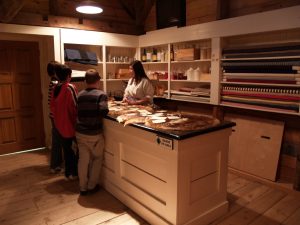
Side Bar – THE LONGEST CANOE Photo 1 F
This is Pat Varty’s favourite. She told me that Kirk drove this across Canada from British Columbia and through the United States to Ontario. “As it was illegal to transport such a long canoe Kirk called ahead to all police detachments and arranged safe passage.” To those who knew Kirk this was not all that unusual.
